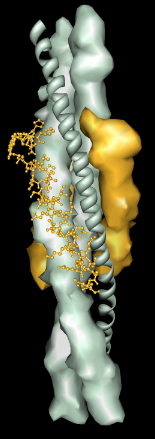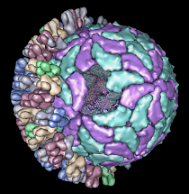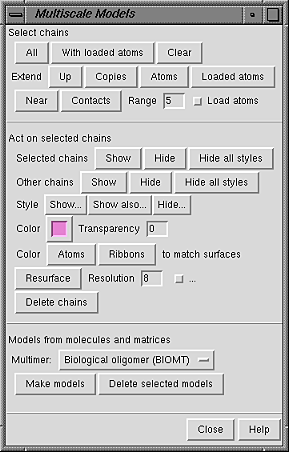
Multiscale Models facilitates the viewing and exploration of macromolecular assemblages, especially large, complicated structures such as viral capsids, ribosomes, spliceosomes, and cytoskeletal fibers. It can also be useful for smaller multimeric systems. Multiscale Models:
If the primary goal is to obtain atomic coordinates for a unit cell, the Unit Cell tool may be more appropriate, but it lacks the efficiencies of low-resolution display.
As a first step toward providing tools for exploring macromolecular complexes, Multiscale Models has many limitations. It is under active development, and suggestions for improvements are welcome (send to chimera-users@cgl.ucsf.edu).
There are several ways to start Multiscale Models, a tool in the Multiscale category. The dialog has three sections:
Contents are described below in an order reflecting the general work flow.It is first necessary to open a PDB file containing either the coordinates for an entire multimeric complex (such as a ribosomal subunit) or coordinates for a lower-order structure and the matrix information needed to generate a multimer.
Under Models from molecules and matrices, the Multimer setting should be adjusted based on the types of matrix information present in the file. Options are:
Clicking Make models generates the multimer, undisplays atomic coordinates, and shows low-resolution surfaces for the chains in the multimer. The surfaces of all copies of a given chain are colored alike; colors are assigned automatically, but can be changed in the Act on selected chains section.
The low-resolution surfaces of all chains in the multimer are opened as a single model. The set of atomic coordinates first opened is still present, although undisplayed. Additional copies of the atomic coordinates will be loaded as needed for various display styles. The surface model and all copies of the PDB model comprise the multiscale model.
Delete selected models deletes each multiscale model with at least one chain selected, except for the single PDB model that was first opened. Although the PDB model is undisplayed, it can be used to remake the multiscale model.
Low-resolution surfaces are efficient for display because they are graphically simple and require much less memory than the corresponding atomic coordinates.
The low-resolution surfaces generated by Multiscale Models are distinct from and independent of the molecular surfaces displayed with Actions... Surface... show or the surface command. The Multiscale Models dialog does not act on these high-resolution molecular surfaces; similarly, the Chimera menus and surface command do not affect the low-resolution surfaces. Currently, the low-resolution surfaces are selectable, while the high-resolution molecular surfaces are not.
Parameters defining the surfaces generated by Multiscale Models can be adjusted in the Act on selected chains section.

By default, the structural hierarchy contains three levels: PDB chain, PDB molecule, and multimer. To define a different set of levels, it is necessary to write a Python script to create the multiscale model instead of using the Make models button. Plans are to develop a user interface for defining the hierarchy.
The default levels sometimes correspond poorly to biologically significant levels of structure. For example, the bluetongue virus capsid (2btv, see the figure) is a two-layered structure, with an outer shell made up of trimers in five symmetry classes and an inner shell composed of dimers. The PDB file contains 17 chains comprising one asymmetric unit of the full virus shell, which is a 60-mer. Levels such as shell, dimer, trimer, and trimer class would be useful in this case. The Python script bluetongue.py loads 2btv and creates the multiscale model with these levels of structure.
A chain can be selected by picking its low-resolution surface in the same way that atoms and bonds are picked (by default, with Ctrl-left mouse button click). If the Shift key is held down at the same time, the selection is added to (or subtracted from, if already selected) the previous selection rather than replacing it. Even though a single chain may appear as disjoint segments, the entire chain is selected, as indicated by highlighting of the low-resolution surface.
When the chain has been selected by picking its low-resolution surface, its constituent atoms and bonds are not selected. However, if the low-resolution surface or any atoms or bonds within the chain are selected, Multiscale Models considers the chain selected. Even though the chain selection highlighting is only visible on the low-resolution surface, the chain remains selected when shown in other display styles.
The Select chains section provides several ways to adjust the selection:

Buttons in the Act on selected chains section control how chains are displayed.
Show and Hide display and undisplay low-resolution surfaces, respectively; Hide all styles undisplays all display styles. This can be done for the Selected chains or for Other chains (the unselected chains within each multiscale model containing at least one selected chain). The rest of the section affects only the selected chains.
The Style for display can be
Color and Transparency apply to the surfaces only (although there are buttons to color the Atoms and Ribbons to match). Clicking the color well allows the color to be adjusted with the Color Editor. Transparency can also be adjusted using the Color Editor (opacity = A = 1 - transparency) or by typing a value in the Transparency field and pressing return (Enter). Transparency can range from 0 to 1; values below or above the range are treated as 0 or 1, respectively.
Resolution (8 by default) is effectively the level of detail in the low-resolution surface; higher numbers give lower resolution. The low-resolution surface is made by counting the atoms in each cell of a three-dimensional grid and then making an isosurface for this occupancy map. The isosurface is smoothed to reduce artifacts associated with computing the surface with an arbitrarily aligned grid. The Resolution is the size in display units (usually angstroms) of the grid cells in each dimension. It is necessary to press return (Enter) or click Resurface to recalculate the low-resolution surface after changes in Resolution or the numerical parameters described below. The checkbutton marked "..." reveals additional adjustable parameters:
Atomic coordinates are loaded for the PDB model first opened, but additional copies of the coordinates are loaded only as needed, when display styles other than low-resolution surfaces are shown.
When possible, copies are made from the coordinates already in memory rather than by opening the original input file multiple times. If all copies of the atomic coordinates have been deleted, however, Chimera will try to open the original input PDB file again. If the file no longer exists in the same location, an error message will appear. There is currently no way of indicating that the file is available in a different location. Solutions are to restore the file to its former location or, in the context of a saved session, to change the location information within the session file before restarting.
Sometimes an excessive amount of coordinate copying is inadvertently set in motion. A dialog enabling the process to be halted will appear after 5 seconds of coordinate copying. Clicking Stop halts copying after the copy in progress is complete.